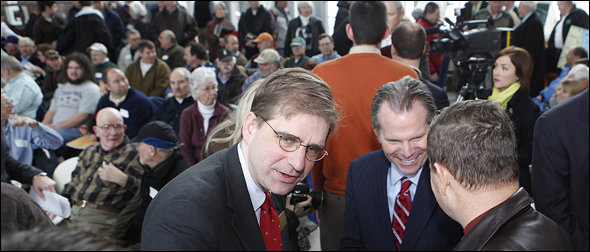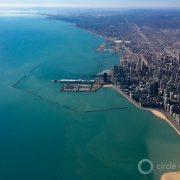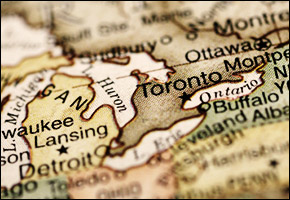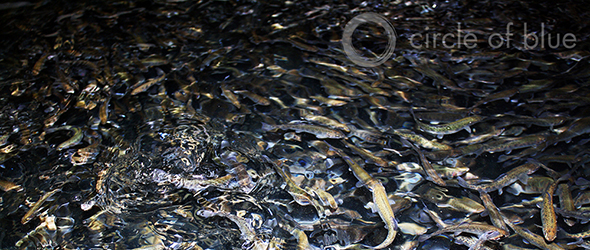Q&A : U.S. Congressman Dave Camp On Asian Carp
Circle of Blue talks with U.S. Rep. Dave Camp (R-Mich.) about fighting the Asian carp battle on the federal front.

By Steve Kellman
Circle of Blue
U.S. House Representative Dave Camp represents a legislative district that covers a huge swath of Michigan’s lower peninsula including the Leelanau Peninsula that juts into Lake Michigan. In January, the Michigan Republican introduced the Close All Routes and Prevent Asian Carp Today bill, also known as the CARP ACT, to the House.The proposal seeks to make actionable the legal motion filed by Michigan Attorney General Mike Cox to the U.S. Supreme Court in December. The Court rejected the motion to close canals and locks to the Great Lakes a month later.
In announcing his proposal, Rep. Camp noted that recent environmental DNA tests suggest that at least some Asian carp have already gotten into Lake Michigan.
Circle of Blue caught up with Rep. Camp earlier this month in Traverse City where he appeared with Attorney General Cox and other state officials during a rally to block the carp from entering the Great Lakes. Camp discussed his legislative efforts to stop the potential Asian carp threat from becoming a reality.
Can you describe the goals of your legislation?
What we want to try to do is keep the Asian carp out, and we believe that closing the canals and the locks is the first thing to do. Then we can address how to continue to operate barge traffic and recreation and other things. The concern is that the eDNA sampling results show that it may be too late. It’s important that we act and we act now, and we act decisively.
Your legislation, the CARP ACT, does have study and mitigation aspects?
It does. It’s about trying to find solutions to the concerns that the Chicago-and northern Indiana-area has raised. The main one we’ve [Michigan] raised is flooding. We want to make sure there are proper procedures in place so that homes and businesses don’t flood. [Closing the locks] is not a win-win for anybody, but I think it’s important that we do that.
Obviously they’re also concerned about any economic impact, but I think it’s important to get the information out about what the alternatives are. What actually is the level of barge traffic? What are the economic needs? How many jobs would be lost and what is the tradeoff? How does that compare to the potential job loss and economic damage if Asian carp were to get into the lakes?
We need to do some education. We need to make sure people understand what their choices are. We’ve gotten some attention with the new federal dollars we got from the appropriations process last year and from the president’s announcement recently. But it’s not just about dollars, we need some action. This is an issue that’s been out there for quit a while.
How long have you been working on this issue?
I really got involved in 2006 to try to get funding for the first electronic barrier and then we found out how inadequate that was and obviously there were some succeeding appropriations for other barriers. What really has been most troubling is it’s been a stop-gap approach, with no comprehensive solution or addressing of the concern. So while an electronic barrier is like sticking your finger in the dike, we really need to figure out how to design the berms, the locks, any sluice gates and any barriers. How do you look at the entire area and issue so that we can prevent Asian carp from getting into Lake Michigan?
There are two petition sites up now. Attorney General Mike Cox is behind one, and Michigan House Democrats have put up another one. Do you worry that the issue might become overly politicized?
I don’t think it is. I agree with Governor Granholm 100 percent on this issue. She’s called for closing the locks, so have I and so has Sen. Stabenow (D-Mich). Legislation is moving through Congress by a Republican in the House, a Democrat in the Senate, and with bipartisan co-sponsorship. I’m not too worried about Web sites and resolutions, although those are helpful. If we can reach people that check our Web sites, that can only help our issue. I haven’t seen their site, but I think the result is probably very similar to the result we’d like.
What’s your opinion of the Asian Carp Control Strategy Framework in general?
So far I think it’s been inadequate. There are several agencies involved and obviously there has to be coordination with state environmental offices as well. I don’t think the coordination has been good enough. I don’t think the agencies have really tried to, in a comprehensive way, address the problem. There’s been some good people working on it and they’ve taken it seriously, but we really need some direction from the top.
We just had a meeting, House and Senate members from the Great Lakes region, with the secretary of the Army Corps of Engineers where she was mispronouncing the names of the rivers. I asked if she’d been there and she said ‘no.’
I told her that’s part of the problem–we really don’t have people at the top levels taking this seriously, and making this a priority for federal agencies. We’re starting to get that attention, but we need to continue to push for it.
Steve Kellman is a Circle of Blue writer and reporter. Reach him at circleofblue.org/contact.











The electrical barriers have not inspired public confidence in stopping the carp. Physical, not electrical barriers are needed.
Kudos to Congressman Camp, AG Cox and the entire MI Congressional delegation for its refreshing display of unity in the face of this threat.
The Michigan Recreation and Park Association is vitally supportive of stopping the invasion of the Asian Carp. Swimming, fishing and boating are key recreation activities that would be seriously harmed if the carp get into the Great Lakes, tributary rivers and inland lakes. The quality of life in the basin depends on preventing the carp from invading the Great Lakes.
“What we want to try to do is keep the Asian carp out, and we believe that closing the canals and the locks is the first thing to do. Then we can address how to continue to operate barge traffic and recreation and other things. The concern is that the eDNA sampling results show that it may be too late. It’s important that we act and we act now, and we act decisively.”
Well, if you close the lock and river there won’t be any barge or water traffic so addressing it after the fact is no a rational choice. EDNA results show nothing! It only shows there is edna there. It does not show how it got there or how many fish. One fish or two fish do not make a population. If you guys were really concerned with Asian Carp why don’ t I hear anybody taking any action to figure out if there are still Asian Carp in lake Erie. They caught Asian Carp in Lake Erie. No testing has been done there. There could be edna everywhere.
Just accept our new overlords:
http://www.facebook.com/pages/I-for-one-welcome-our-new-Asian-Carp-overlords/274143201165
Folks,
EPA states and asks:
“Excess nutrients like nitrogen and phosphorous entering the nations waters create pollution that is hard to track, contain, and control. Nutrient pollution is as damaging to our waters as it is complex, so finding effective ways to address it is critical. EPA and State agencies have used various approaches to tackle the problem but much more is needed to protect water bodies from these pollutants.
• What critical elements need to be included in an effective nutrient strategy?
• How should the strategies differ for protecting healthy and functioning watersheds versus those that need to be significantly restored due to previous pollution?
• What has worked for your organization, state, or tribe in controlling nutrient pollution? What hasn’t?”
Response:
The great mid-American River system is the cesspool for thousands of cities, industries and farms. Many of the pollutants include soils which have been “washed” with industrial agricultural chemicals (non-point pollution) which when the soil is eroded, move to the rivers. These pollutants then grow algae and other micro-organisms, some of which create dead zones in the Gulf of Mexico.
Fortunately, carp (and other critters) feed on these micro-organisms, thus reducing some of the pollution. However, the native fish population pays the price because of the disruption of their food chain. Studies now estimate that Asian carp (mostly Bighead and Silver) make up 95% of the fish biomass in most of these rivers. The Asian carp population has exploded over the past few years and now threaten the seven billion dollar fishing industry of the Great Lakes. See: Asian Carps of the Genus Hypophthalmichthys (Pisces, Cyprinidae) ? A Biological Synopsis and Environmental Risk Assessment; http://www.fws.gov/contaminants/OtherDocuments/ACBSRAFinalReport2005.pdf ; Also see the Youtube documentaries: Part 1: http://www.youtube.com/watch?v=yS7zkTnQVaM&feature=PlayList&p=DB08107B501DF1D8&playnext=1&playnext_from=PL&index=47; Part 2: http://www.youtube.com/watch?v=2ChwJiKKBdA&feature=PlayList&p=DB08107B501DF1D8&playnext=1&playnext_from=PL&index=48
Would a compromise work? First by reducing the Asian carp population by removing the breeders and secondly, by managing the carp population so as to allow native fish to recover. That way we allow the Asian carp to continue cleaning nutrients from the rivers and re-establish the native fish. It seems highly improbable to totally remove all Asian carp. There are additional benefits, namely the beneficial use of the harvested carp.
The ACBSR final report concluded that the physical removal of the carp was the best working solution. Mention was made of training vast numbers of fisher folk on how to catch carp. Bait and hook does not work since the carp are filter feeders. Only purse (or hoop) nets seem to work for skiff quantities. What is needed is a commercial approach to harvesting carp.
Carp Catchers Cooperative has such a plan (on digital record). See: Carp Catchers Co-op, http://carpcatchersco-op.wetpaint.com/page/BUSINESS+PLAN+–+A+BRIDGE+OVER+TROUBLED+WATERS
Carp Catchers Cooperative will be formed as a social entrepreneurial enterprise (L3C – Limited Liability Company), will build a fleet of three ships which will be able to harvest and process two tons of fish per hour. Currently, we have completed our initial material take-off and weight calculations and have a good start on the sourcing and pricing of materials and equipment. We have extensive research notes on nearly all technical aspects of the project. We are in need of about $300,000 grant with which to produce our working drawings, sourcing and pricing and submission to and seek approval by regulatory agencies. Please take a look at the Youtube videos and visit our website, then send me an email as to how you can help. Please pass this email letter on to everyone who can help us with the funding.
Sincerely yours,
Jim Miller, President
Mutual Aid Society of America, Inc.
jimmiller5417@yahoo.com
I think the politics are clouding the idea that fences will work.. We really need to invest in processing plants. (creating jobs) Find uses for them.. some ideas is using the Omega 3 fish oils, cat and dog food, ground up fertilizer being used with some farmers now. cattle food. also research there is need for them overseas in china one for fish head soups and they smoke them saying better than salmon. these are just a few ideas we could invest in to create many need jobs in the economy today. Need to get your own agendas off the table and think clear about this. Fishermen can fish. Barges can haul, processing plants will hire and expand. almost endless. Creating a market is key to help bring the high counts of fish down. I they are not fished they WILL continue to populate. Common knowledge..Do something to help.